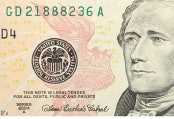Inside the highway and bridge industries

By John Latta, [email protected]
A new report from the Federal Reserve Bank of San Francisco suggests that highway grants play a very positive short-, mid- and long-term role in building state gross product. And “stimulus” dollars do some of the best work.
Federal highway grants to states appear to boost economic activity in the short and medium term. The short-term effects appear to be due largely to increases in aggregate demand. Medium-term effects apparently reflect the increased productive capacity brought by improved roads. Overall, each dollar of federal highway grants received by a state raises that state’s annual economic output by at least two dollars, a relatively large multiplier.
The bank’s research springs from its observation that while public infrastructure spending programs, from the Depression-era Works Progress Administration and Tennessee Valley Authority through to the American Recovery and Reinvestment act of 2009 (a.k.a “The Stimulus”), “surprisingly little empirical information is available about the effect of public infrastructure investment on economic activity over the short and medium term.”
The report delves into the dynamic effects of public investment in roads and highways on gross state product (GSP). A key value in this approach is that uses the federal highway grants processes to examine how transportation spending affects economic activity.
And what did the big bank find?
“We find that unanticipated increases in highway spending have positive but temporary effects on GSP, both in the short and medium run. The short-run effect is consistent with a traditional Keynesian channel in which output increases because of a rise in aggregate demand, combined with slow-to-adjust prices.
“In contrast, the positive response of GSP over the medium run is in line with a supply-side effect due to an increase in the economy’s productive capacity.
“We also assess how much bang each additional buck of highway spending creates by calculating the multiplier, that is, the magnitude of the effect of each dollar of infrastructure spending on economic activity. We find that the multiplier is at least two. In other words, for each dollar of federal highway grants received by a state, that state’s GSP rises by at least two dollars.”
The multiplier effect
The multiplier effect helps gauge the effectiveness of government spending by measuring the dollar change in economic output for each additional dollar of government spending. A multiplier of two implies that when government spending increases by one dollar, economic output rises by two dollars.
According to the San Francisco study, “multipliers for federal highway spending are large.” The report finds that when it come to highway grants and GSP:
• On initial impact, the multipliers range from 1.5 to 3.
• In the medium run, the multipliers can be as high as eight.
• Over a 10-year horizon, there is an average multiplier of about 2.
The bank was actually surprised to find that these numbers were noticeably larger than those typically found in the literature on the effects of government spending.
Stimu-dollars
So just how did the infusion of $27.5 billion in federal highway grants to states as ARRA stimulus money affect state GSPs?
As the bank notes, “ARRA was designed to have strong short-term effects. In general, infrastructure projects are not viewed as effective forms of short-term stimulus because of the long lags between authorization, planning, and implementation.
By the time the projects get under way, a recession may be over. The extra spending could ultimately end up feeding an already booming economy.” Clearly not a problem in this case.
To address this problem the Administration said the money had to be used quickly.
But highway spending, even rapid highway spending, in a recession (when productive capacity is underutilized)might affect output in a substantially different way than spending during more normal times, the bank hypothesized.
So the bank looked into whether unanticipated changes in highway spending in 2009 and 2010 had a different effect on GSP than in other years they looked at. And found that the multiplier was around four times.
“This suggests that highway spending can be effective during periods of very high economic slack, particularly when spending is structured to reduce the usual implementation lags,” says the bank report.
SAY WHAT?
“I think they do represent the wave of the future in the 10-15 largest urban areas,”
— Bob Poole, director of transportation policy at the Reason Foundation, on HOT “dynamic pricing” toll lanes.
Red State, Blue State, Slow State, Stopped State.

A new analysis by the Washington Policy Center shows that nine of the top ten cities with the worst traffic delays in the country are blue states. The odd one out is number 10, Austin, Tex.
In cities with more than the average congestion-caused delays, 64 percent are in blue states and 25 percent are in red states.
If you are in a blue state you waste, on average, 21.6 hours stuck in traffic every year but in red states only 11.6 hours. If you are in a red state city, that delay comes to 451 hours a year and in blue state cities it is 931 hours.
Among cities with below-average congestion delays nearly half are red states and 31 percent are blue.
The Center (www.washingtonpolicy.org)took INRIX’s National Traffic Scorecard that ranks the top 100 cities traffic-congestion-wasted hours data and overlaid voting trends from the past four presidential elections.
Big Belly Knows Garbage
The Colorado Department of Transportation (CDOT) says it is testing a little-known technology to improve its efficiency. CDOT has bought and installed 11 BigBelly Solar Garbage Compactors at a rest area off I-25 near Fort Collins. The compactors will replace traditional/standard garbage collection trash cans.
“These garbage compactors are basically ‘smart’ trash cans that run on solar energy,” says CDOT deputy maintenance superintendent Phillip Anderle. “Compactors can be monitored remotely via computer or smartphone, so staff will only have to go to the rest area when a compactor sensor registers that it needs to be emptied.”
Crews are expected to increase their efficiency and over time the compactors are anticipated to save money, reduce the volume and frequency of trash pickups, conserve fuel, save staff time, and decrease wear and tear on CDOT vehicles. The systems as tested costs about $55,000 and CDOT expects to recover the cost of the system within the next eight years.

Careful what you put into your light truck fleet tanks, says AAA
A recent AAA survey found a strong likelihood of consumer confusion and the potential for voided warranties and vehicle damage as a result of the Environmental Protection Agency’s recent approval of E15 gasoline. AAA says 95 percent of consumers surveyed have not heard of E15, the newly approved gasoline blend that contains up to 15 percent ethanol.
Only about 12 million out of the more than 240 million light-duty vehicles on the roads today are approved by manufacturers to use E15 gasoline, based on a survey conducted by AAA of auto manufacturers. AAA automotive engineering experts also have reviewed the available research and believe that sustained use of E15 in both newer and older vehicles could result in significant problems such as accelerated engine wear and failure, fuel-system damage and false “check engine” lights for any vehicle not approved by its manufacturer to use E15. Unsuspecting consumers using E15 could end up with engine problems that might not be covered by their vehicles’ warranties.
“The sale and use of E15 should be suspended until additional gas pump labeling and consumer education efforts are implemented to mitigate problems for motorists and their vehicles,” says AAA President and CEO Robert Darbelnet. “Consumers should carefully read pump labels and know their auto manufacturer’s recommendations to help prevent any problems from E15.”














